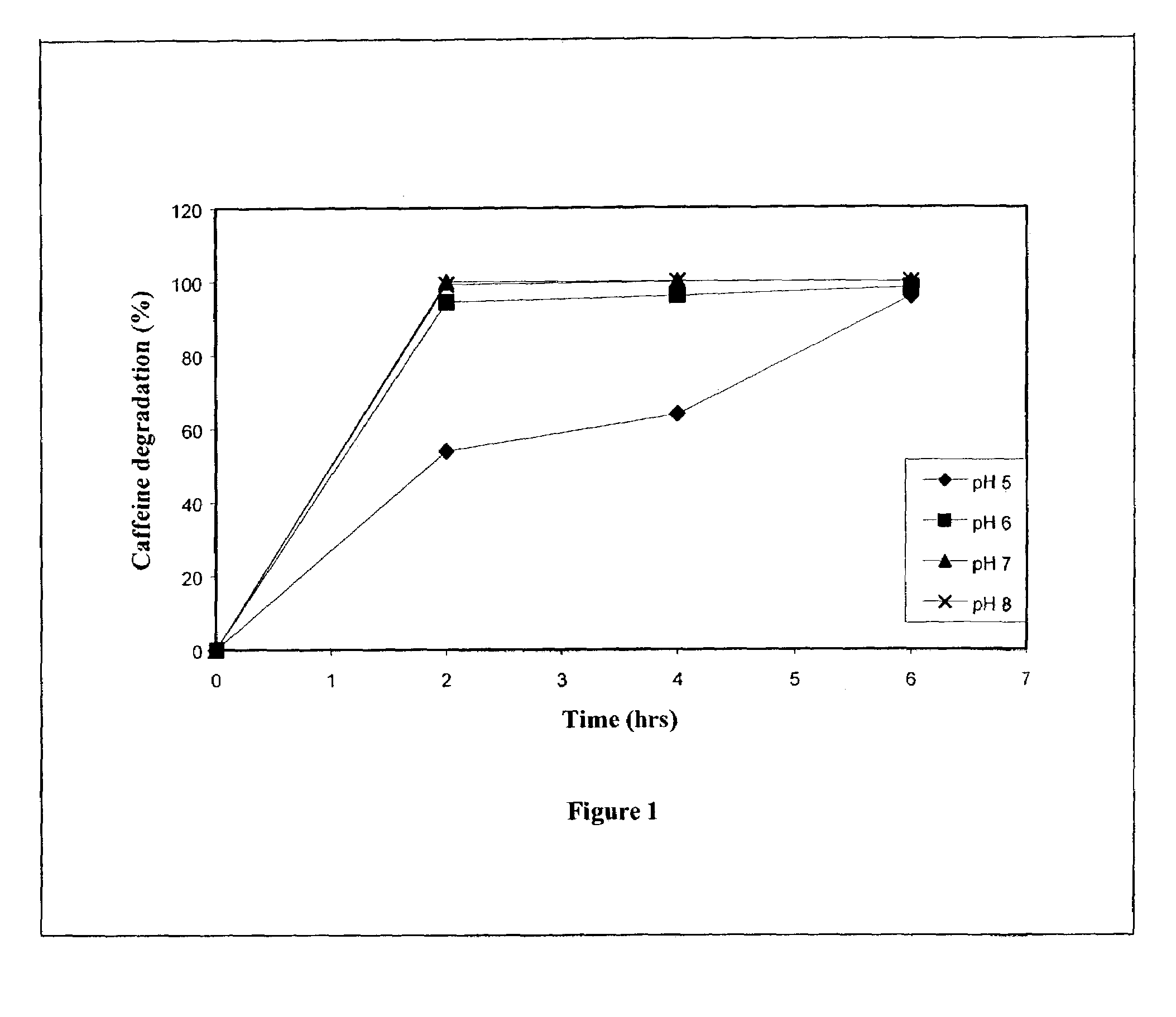Decaffeinating microorganism and process of bio-decaffeination of caffeine containing solutions
a technology of biodecaffeination and microorganisms, which is applied in the direction of biocide, plant/algae/fungi/lichens, biocide, etc., can solve the problems of toxicity, flavor elements and oil are drawn off from beans, and stimulate the central nervous system, etc., to achieve simple, safe and efficient
- Summary
- Abstract
- Description
- Claims
- Application Information
AI Technical Summary
Benefits of technology
Problems solved by technology
Method used
Image
Examples
example-1
[0096]After screening of various microorganisms isolated from coffee processing wastes, a bacterial culture is selected on the basis of caffeine degrading ability in a well-defined liquid media containing caffeine. Isolation of the microorganism was done by mixing one gram of soil sample with 100 ml of caffeine liquid medium in a 250 ml flask and incubation for 72 hrs at 30° C. in an orbital rotary shaker set at 150 rpm. Caffeine agar medium was prepared and poured into petri plates. Then ten-fold serial dilutions (10−1 to 10−9) of the above grown culture were made and 0.1 ml of the dilutions was inoculated on to each plate and incubated at 37° C. for 2 days.
[0097]Isolated colonies growing on the above plates were selected and purified further to obtain pure cultures. On the basis of colony morphology, well-separated colonies of the caffeine degrading bacteria formed on incubated caffeine agar plates were selected and transferred aseptically into fresh caffeine agar plates and incub...
example-2
[0102]A loop full of actively growing culture of Pseudomonas alcaligenes is transferred to 100 ml of nutrient broth containing 0.3-g / L caffeine and incubated at 30° C. in a rotary shaker at 120 rpm for 24 hrs. 5 ml of the 24 hrs grown pre inoculum is transferred to 100 ml of nutrient broth containing 1 g / L caffeine and incubated at 30° C. for 48 hours on the rotary shaker. Biomass accumulated for 24 hours is harvested by centrifugation for 20 min in a bench top centrifuge at 16,000-x g at 4° C.
[0103]This biomass is aseptically transferred into a 500 ml flask containing 100 ml of Caffeine liquid medium containing 0.5-g / L g of caffeine and incubated at 30° C. on the rotary shaker for 48 hrs; 1 gm wet weight of the pellet of above induced biomass is suspended in 2 ml of 0.1 M phosphate buffer. This suspension is then added to a flask containing 10 ml of caffeine liquid medium containing 1 g / L caffeine adjusted to a pH of 5.0 and incubated at 30° C. under agitation on a rotary shaker at...
example 3
[0104]The cultivation of the organism is carried out as in example 1. However, the pH of the medium for decaffeination is adjusted to 6.0. The degradation of caffeine is much more efficient than at pH 5, giving values of 94.5% at 2 hrs and 98% at 6 hours of incubation (FIG. 1).
PUM
| Property | Measurement | Unit |
|---|---|---|
| temperature | aaaaa | aaaaa |
| induction time | aaaaa | aaaaa |
| concentration | aaaaa | aaaaa |
Abstract
Description
Claims
Application Information
 Login to View More
Login to View More - R&D
- Intellectual Property
- Life Sciences
- Materials
- Tech Scout
- Unparalleled Data Quality
- Higher Quality Content
- 60% Fewer Hallucinations
Browse by: Latest US Patents, China's latest patents, Technical Efficacy Thesaurus, Application Domain, Technology Topic, Popular Technical Reports.
© 2025 PatSnap. All rights reserved.Legal|Privacy policy|Modern Slavery Act Transparency Statement|Sitemap|About US| Contact US: help@patsnap.com


